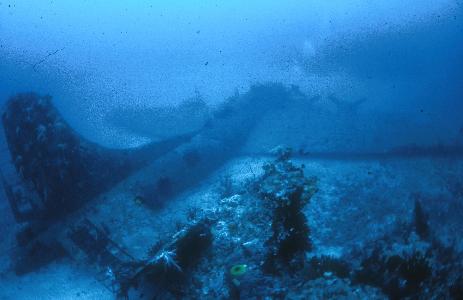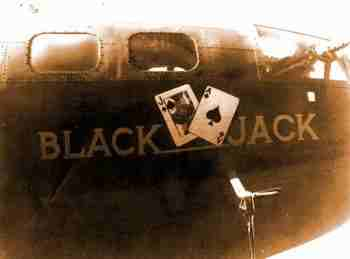
Black Jack B17
|
THE CREW MEMBERS | |
|
PILOT |
CAPT. RALPH DELOACH |
|
CO-PILOT |
LT. JOSEPH MOORE |
|
NAVIGATOR |
LT. CHARLES SHAVER |
|
BOMBARDIER |
LT. MANUEL DIAZ |
|
FLIGHT ENG. |
DELDERT SMITH |
|
RADIO OPERATOR |
GEORGE PAEZIOSO |
|
WAIST GUNNER |
EDWARD JAMES |
|
BALL TURRET |
JOSEPH WILSON |
|
WAIST GUNNER |
JIM PETERSON |
Blackjack, possibly the most famous bomber in the South West
Pacific theatre of operations. ( S.W.P.T.) Ditched whilst returning
from a raid on Rabaul, she now lies in 50 meters of water off Boga
Boga village in the Milne Bay province of Papua New Guinea.
Flown most of her life by Ken McCullar until he was killed in a
take off crash, it was McCullar who flew her to glory and into the
history books. However on July 12th she was piloted by De-Loach and
Moore.
Blackjack was part of the 43rd bomb group and the 5th Air Force. And part of 10 B17s on her way to attack Rabaul, forced to ditch through lack of fuel and severe thunderstorms. She now lies on a white sandy bottom and is completely intact, even her guns move in their mounts. Visibility is usually excellent, 80 - 150 ft and can be visited by experienced divers.
Blackjack is obeying B17 Flying Fortress. A little after midnight on July 11, 1943 she took of from Port Moresby, Papua New Guinea to attack a Japanese airstrip at Rabaul on New Britain and did not return.
She was discovered almost by accident by 3 local divers from Lae, she lies in deep water on the seabed a thin skin of coal encrusting her. She is beautifully preserved and totally intact - ammunition belts still wend their way to the machine guns, which still move stiffly in their mounts.
Papua New Guinea abounds with the reminders of the waste of war, but most of the relics have been stripped or salvaged for their worth as scrap. Such a complete aeroplane is unique, a genuine historical treasure trove.
The Flying Fortress was a big bomber. Powered by four 1200 horsepower engines, the B17 was 74' long, with a wingspan of 103 ', and weighed over 20 tons. Thirteen machine guns jutted from her turrets and gunports to protect her crew of ten men.
B17 number 41-24521 was rolled out of Boeing's Seattle factory one humid day in July of 1942, and 6 weeks later she joined the 43 Bomb Group, based in northern Australia. The 43rd was part of the 5th Air Force, which had been formed to provide the aerial support for General Douglas MacArthur's return to the Philippines and the defeat of the Japanese Empire, but in September 1942 Japanese forces were within 30 miles of Port Moresby, the last major Allied position in New Guinea. The 5th Air Force was holding a desperate holding action.
Fate had chosen 41-24521 to be more than just one of over 12000 Flying Fortresses built for the U.S. Army Air Forces. The brand new bomber was assigned to Capt. Ken McCullar and his crew and was given the nick name … BLACKJACK, an obvious choice when the last two digits of her air force serial number were ''21''.
In the air, the bond between man and machine is real. In war it
becomes even stronger and such a bond was forged between Ken
McCullar and BLACKJACK. Ken McCullar was a flamboyant gambler and a
totally fearless aggressive pilot - he even had his ground crew fit
a extra machine gun in BLACKJACK'S nose, fired by a button on his
control wheel, so he could use the big bomber to duel with Japanese
fighters. He pioneered a tactic called ''skip bombing'' -night
attacks against Japanese shipping in port or at sea. The Fortresses
would roar along the moon slick at minimum altitude, releasing their
bombs a hundred feet short of the targeted skipping them off the
water into the side of the enemy ships at the waterline. It was
dangerous, but devastatingly effective.
BLACKJACK and Ken
McCullar became a legendary team. His name is still spoken with a
kind of awe whenever 5th Air Force veterans gather. Flying as many
as three combat missions in one day, BLACKJACK and McCullar always
came back, sometimes against all odds.
There was a night in November 1942 when 5 Japanese destroyers, laden with troops dashed from the navel bastion at Rabaul into the Huon Gulf. The B17's were sent to stop them. McCullar made his first bomb ran at 200ft as tracers lit up the soft darkness, and BLACKJACK was rocked by the bursts of heavier shells. His bombs hit just off the end of the ship, but the enemy fire had set off ammunition in the B17 tail section, starting a fire. The crew was able to extinguish it as McCullar positioned his plane for another bomb run. BLACKJACK took more hits and shell fragments wounded three of the crew, but their bombs started a blasé in the bow of the destroyer.
Japanese destroyers could put up a devastating shield of fire, and BLACKJACK was hit hard when McCullar attempted a third attack. The left outboard engine was hit and the controls were shot away. Although his aeroplane was crippled McCullar made a fourth bomb run, rocking the stricken Japanese ship, but taking more damage to his aeroplane.
With two bombs left, McCullar made a fifth and final attack, this
time from 4000ft. That cost him the inboard engine on the right
wing, which was hit somewhere in the fuel system, and cut out. With
only two good engines, BLACKJACK began to loose altitude, and
McCullar and his crew were faced with the long climb over the Owen
Stanley mountains, which rise to a height of two miles, forming a
rugged spine along New Guinea.
The damaged left engine could have
caught fire or exploded at any time - McCullar could see it glowing
cherry red in the darkness, but there was never any doubt that he
would stay with BLACKJACK to the end. The propeller finally ground
itself loose from the engine and spun off into the darkness. The
motor cooled down but BLACKJACK was still sinking to earth. While
the crew threw out all their ammunition and other loose equipment to
lighten the plane, the pilots tried to restart the damaged engine,
and were finally able to get partial power from it BLACKJACK began
to climb, very slowly. It took two and a half-hours to reach 10000
feet, just enough for the bomber to make it through a mountain pass
and set the plane down safely on the ground at Port Moresby. His
persistence had paid off - later that night the destroyer HAYASHIO
exploded and sunk.
After McCullar's return to Moresby another plane was dispatched to finish off the HAYASHIO and as the aircraft entered her bomb run the vessel blew up and sank. While on her way back to MORESBY she ran out of fuel and ditched at Cape Vogel this was an a Australian BEAUFORT A-28-2 and it was this plane we were searching for when we found BLACKJACK.
BLACKJACK and McCullar lived charmed lives together, and the Japanese could not stop them. But McCullar died in a fiery take off crash of another aeroplane, and BLACKJACK fell victim to the New Guinea weather. Caught up in a violet storm, with a malfunctioning engine vibrating so badly it threatened to tear itself from the wing and the other on the same side giving only limited power, her crew was unable to hold a straight course and became hopelessly lost. With fuel running low they tried to land on the shallow waters of a reef, but missed and landed in deep water. Three of the crew was wounded in the crash, but all friendly natives rescued 10 men and an Australian coast watcher named Eric Foster. The next day after a radio call had been sent out by Foster a small seaplane arrived to take of the wounded and leave supplies for the rest of the survivors Later a P.T.boat arrived to take the remaining crewmembers to Goodenough Island where they were flown back to Moresby.
The story of BLACKJACK and Ken McCullar has been told in a recant documentary titled BLACKJACK'S LAST MISSION, filmed on location in P.N.G. it covers the history of BLACKJACK and includes interviews with crew members, villagers and other promandant people. It also includes some incredible world war two and underwater footage.

